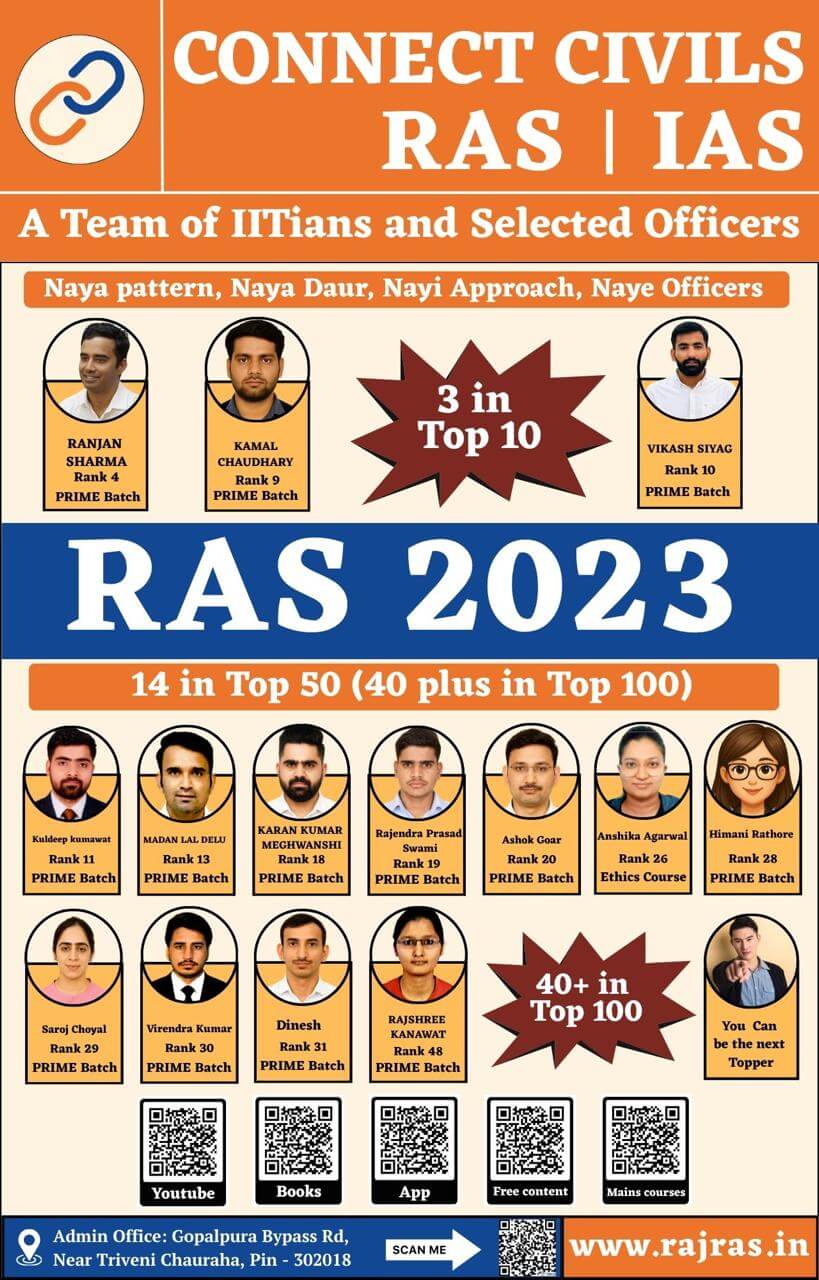Folk Dance of Rajasthan is a vibrant expression of the state’s rich cultural legacy and holds a special place in Rajasthan History. Regional dances like Ghoomer, Dhol, Ger, Agni, Bam, and Languriya bring alive the festive spirit, while professional performances such as Bhawai and Kachhi Ghodi showcase skilled artistry. Caste-based folk traditions like Kalbeliya, Bhil, and Mev further reflect the diverse social and cultural identities of Rajasthan’s communities.
Folk dance of Rajasthan
Folk dances of Rajasthan trace their origin to rural customs and traditions. These dances form an integral part of people’s lives and are performed on important occasions and festivals. The rise of princely states during medieval times, also added to growth of folk dances, as the rulers gave patronage to art & crafts. Jaipur Gharana is supposedly the first gharana of Kathak dance. These dances can be divided into the following category.
Regional Dances
Regional dances are closely associated with specific parts of Rajasthan, reflecting the unique traditions, festivals, and customs of each area. The following are detailed descriptions of the major regional dances:
Ghoomar Dance
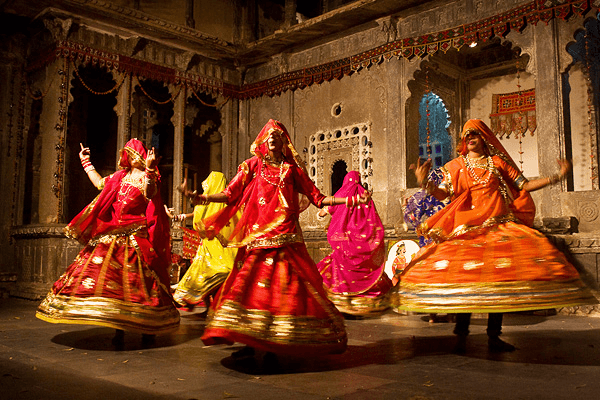
- Region: Performed across Rajasthan, predominantly in Mewar, Marwar, and Hadoti regions.
- Performed By: Originally by Bhil Community, adopted by different communities including Rajputs (Women).
- Occasions: Rajput Marriages, festivals like Teej and Gangaur, and other celebratory events.
- Features:
- Graceful circular movements performed in a synchrony by women dressed in vibrant Ghagra (skirts).
- Women cover their faces with a veil (ghoonghat), symbolizing modesty.
- Accompanied by traditional songs such as “Mein Ghoomar Nachungi” and instruments like the dhol and sarangi.
- Cultural Significance: Symbolizes the richness and hospitality of Rajasthani culture.
Dhol Dance
- Region: Mewar.
- Performed By: Men, often in pairs or groups.
- Occasions: Festivals like Holi and processions.
- Features:
- Performed with vigorous energy to the beats of the dhol (drum).
- Male dancers perform acrobatic movements showcasing strength and agility.
Ger Dance
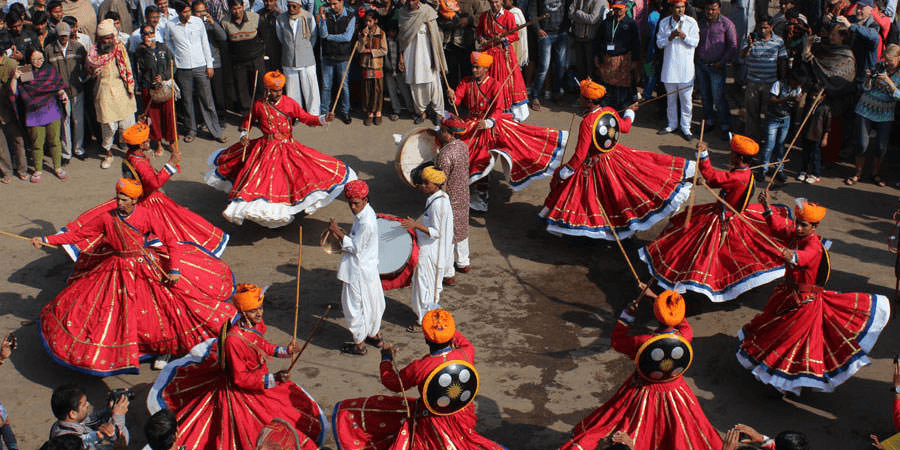
- Region: Marwar and Shekhawati regions.
- Performed By: Men, predominantly from the Bhil community.
- Occasions: Celebrated during Holi.
- Features:
- Dancers form a circle, carrying colorful sticks and moving rhythmically.
- Use of powdered colors thrown into the air, creating a festive atmosphere.
Languriya Dance
- Region: Eastern Rajasthan, primarily Alwar and Bharatpur.
- Performed By: Men and women.
- Occasions: During fairs and festivals.
- Features:
- Celebratory dance featuring cheerful movements.
- Songs in praise of local deities and folklore are an integral part.
Ghudla Dance
- Region: Shekhawati region.
- Performed By: Women.
- Occasions: During Gangaur festival.
- Features:
- Women balance brass pots on their heads, adorned with lamps or flowers.
- Dance is performed in honor of Goddess Parvati.
Agni Dance
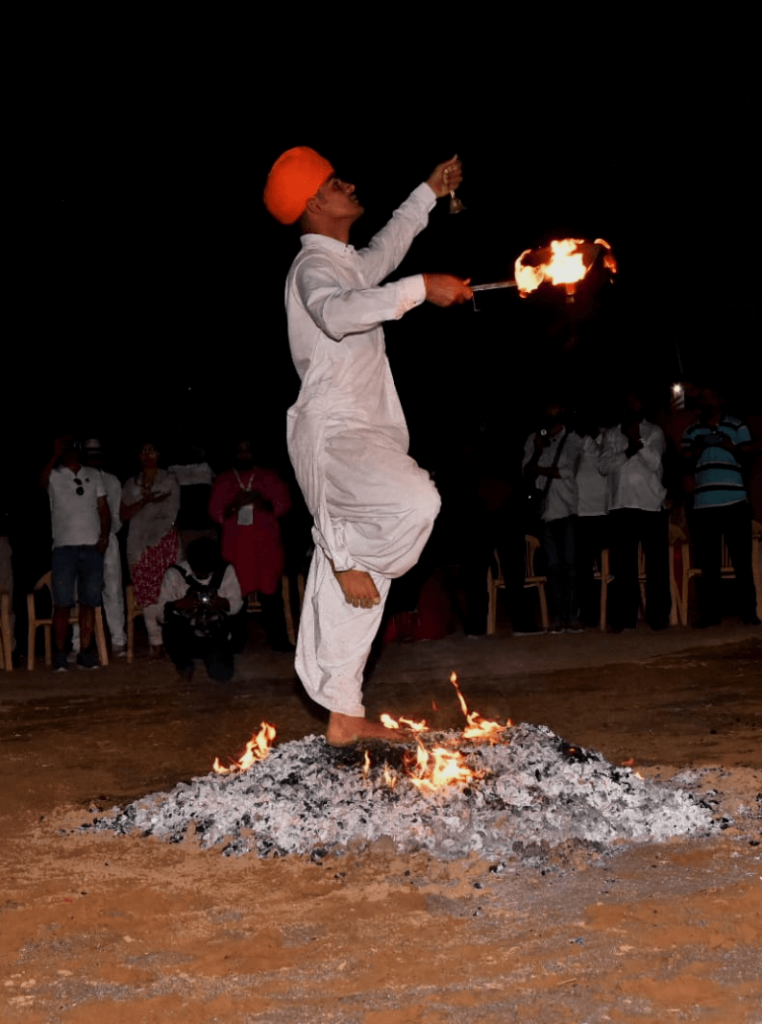
- Region: Western Rajasthan ,particularly Katariyasar village of Bikaner district.
- Performed By: Jasnathi sect.
- Features:
- Dance performed around a sacred fire (agni), symbolizing devotion and spirituality.
- Dancers hold burning torches and perform with precision to avoid injury.
Bam Dance
- Region: Eastern region of Rajasthan particularly Bharatpur and Alwar.
- Performed By: Men only on the beats of a big Drum (called Bam).
- Occasions: on occasion of Holi festival
- Features:
- Two men play it with the help of big sticks and the dancers dance while throwing colourful strings and feathers tied to their hands in the air.
- It is called ‘Bam Rasiya’ because Rasiya is sung with Bam (drums)
Jhumar Dance
- Region: Hadoti region.
- Performed By: Women with the help of sticks, mostly during marriage ceremonies.
- Occasions: Celebrations of auspicious events.
Professional Dances
These dances are performed by professional artists and are known for their intricate techniques:
Bhawai Dance
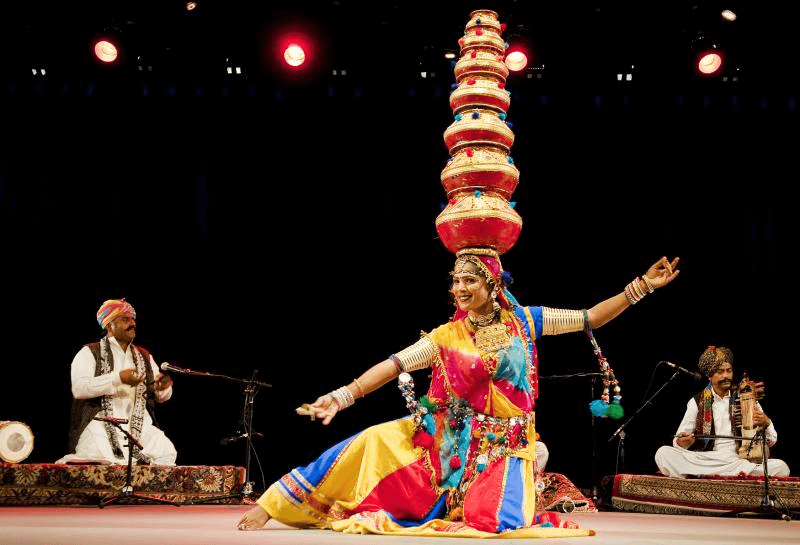
- Region: Udaipur, Chittorgarh, Banswara, Dungarpur.
- Performed By: Both men and women.
- Famous Person : Mrs.Krishna Vyas Chhangani, from Jodhpur (Rajasthan)
- Features:
- Women balance multiple earthen or brass pots on their heads while dancing.
- Often performed on the edge of swords or on glass pieces, showcasing balance and skill.
- Accompanied by instruments like the dholak, sarangi and harmonium.
Kachhi Ghodi Dance
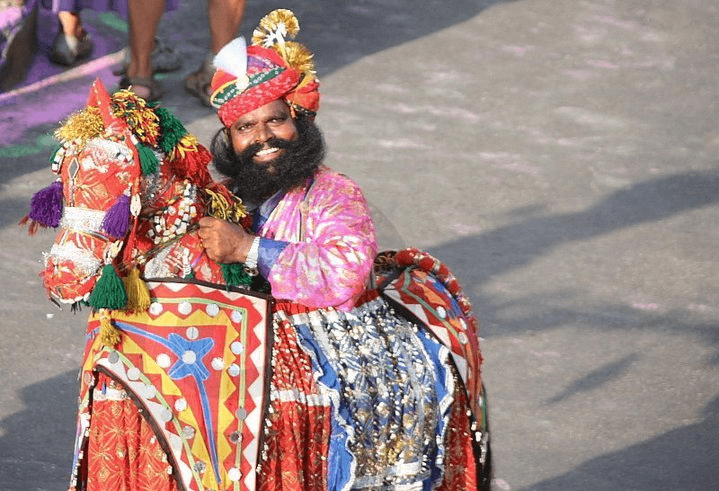
- Region: Shekhawati region.
- Performed By: Men.
- Features:
- Dancers wear costumes resembling horses and narrate tales of bravery through the performance.
- Performed to entertain guests during weddings or festive events.
Terah Taali Dance
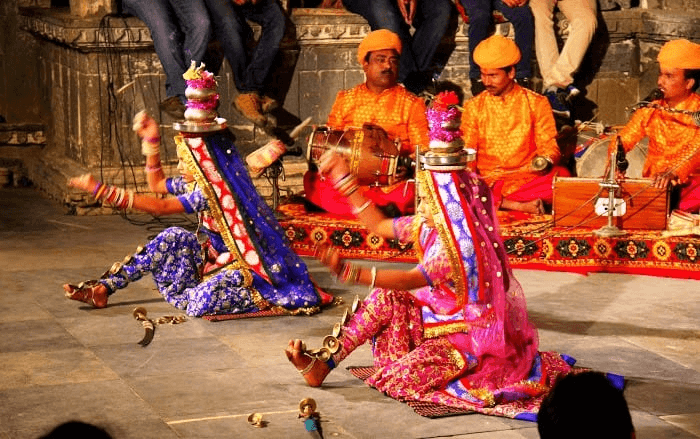
- Region: Ramdevra, Udaipur, Jaisalmer.
- Performed By: Woman from Kamad tribe while sitting on the floor before Baba Ramdeo’s image.
- Features:
- Thirteen brass discs (called manjiras) are tied to various parts of the body.
- Dancers strike these manjiras rhythmically while singing devotional songs dedicated to Baba Ramdev.
Caste-Based Dances
Gurjar Caste
Chari Dance
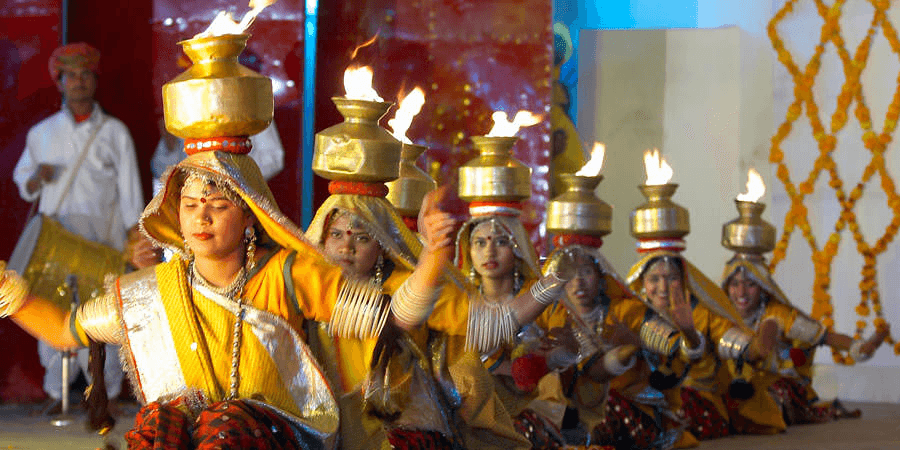
- Women perform while balancing brass pots on their heads, often filled with lit lamps, showcasing their balancing skills.
- ‘Falku Bai’ is a famous dancer of chari dance.
Kalbelia Caste
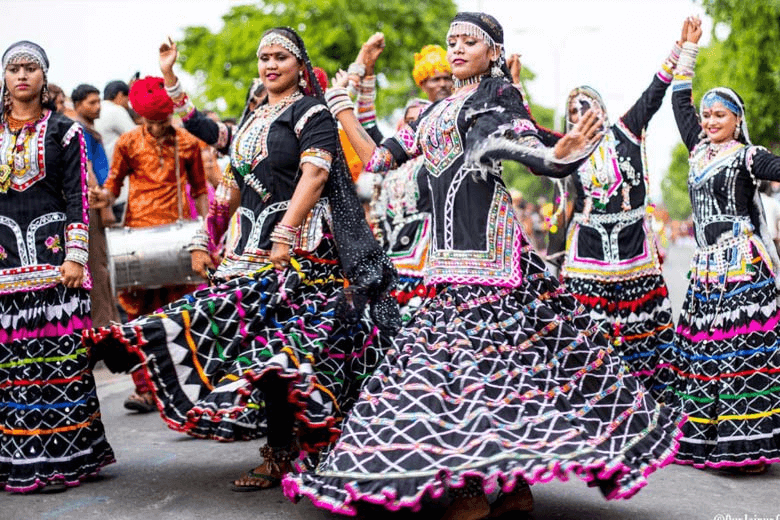
- Indoni Dance
- Features: Performed by Kalbelia men and women in a circular motion to the tunes of pungi and khanjari.
- Costumes and ornaments are highly artistic, reflecting sensuality and elegance.
- Shankariya Dance
- Features: A highly attractive duet dance based on love stories.
- Movements: Graceful body movements showcasing a romantic narrative.
- Panihari Dance
- Features: A duet dance performed by Kalbelia couples while singing Panihari songs.
Mev Caste
- Ranvaja Dance
- It is a couple dance of Mev.
- Features: A traditional dance that incorporates warrior-like movements and songs.
- Ratvai Dance
- Performed by Women of Mev caste.
- Features: Celebrates community festivals with rhythmic steps and lively tunes.
Bheel Tribe
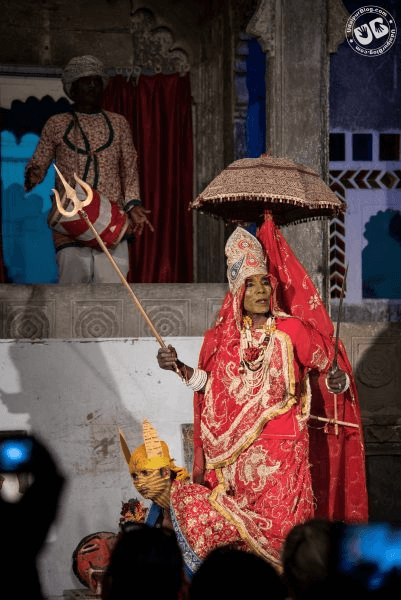
- Gair Dance
- Performed in Mewar region. However, variations like the Dandi Gair are found in the Marwar region and Geendad is found in the Shekhawati region.
- Performed by Men of Bhil tribe
- Features: Performed during Holi festivals and community celebrations, involving circular formations and rhythmic foot movements.
- Gavri Dance
- Udaipur, Rajsamand and Chittorgarh districts of Rajasthan.
- Women do not take part in Gavri and all the female roles are played by men.
- Features: A ritualistic dance performed in devotion to Goddess Gavri and Lord Shiva, often incorporating mythological stories.
- Yudh Dance
- Features: Male dance, depicts scenes of battle with energetic movements and martial stances.
- Dwichakri Dance
- Features: It is a couple dance, Known for its vibrant and synchronized movements involving circular patterns.
- Hathimana Dance
- Performed at weddings.
- Features: Men perform this dance while kneeling, highlighting their strength and endurance.
Garasia Tribe
- Loor Dance
- Features: A group dance performed during Holi, involving colorful costumes and lively steps.
- Valar Dance
- This is a couple dance in which no musical instruments are used.
- A traditional dance depicting agricultural activities and folk tales.
- Jawara Dance
- Features: Celebrates the sowing and harvesting of crops, showcasing community unity.
- The dance is performed with jawar in hand
Kathodi Tribe
- Kathodi Dance
- Features: Performed during Navratri, accompanied by traditional songs and vibrant costumes.
- Mavaliya Dance
- Performed by Man of this tribe.
- Holi Dance
- Couple dance, on the occasion of Holi Festival

